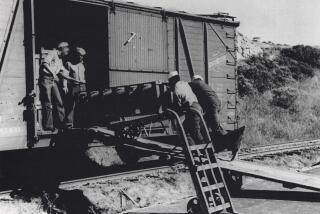Continuing Support in Military Medical Program Helps Gulf War POWs Adjust
- Share via
PENSACOLA, Fla. — Beneath Maj. Joe Small’s yellow Iraqi prison uniform, on display in an aviation museum, is his reflection: “Everybody calls me a hero--I don’t feel like a hero, just a guy who had a bad day.”
The American public’s support for prisoners of war repatriated after the Persian Gulf War was immense. But while it helped lift their morale, it also bordered on too much of a good thing, say Navy psychiatrists studying how the 21 men and women are adjusting.
“Many of them are so overcome with public support that they are kind of in a burnout syndrome: so many appearances and talks, people wanting part of their time,” said Capt. James C. Baggett, chief of psychiatry at the Naval Aerospace Medical Institute.
On the other hand, knowing they could rely on sympathy at home made it less traumatic for those POWs who were pressed into denouncing their government on Iraqi television.
“Many of the guys in Desert Storm who were forced to do things, said they did so knowing the American public was supporting them,” Baggett said. “Probably that factor in itself is going to have a lot of continued assistance down the line.”
Five Marines and three Navy pilots captured by Iraq underwent five days of physical, psychiatric and psychological tests last month at the institute on the Pensacola Naval Air Station. The other 13, from the Army and Air Force, will arrive in about six months. Annual visits are planned.
The ex-POWs, some of whom were beaten during interrogation, are in good physical and mental shape, but they have had some inner doubts, Baggett said. “Their biggest fear was ‘How did I do?’ and ‘Did I do the best I could?’ and how did others perceive them,” he said.
The Navy’s Repatriated Prisoner of War Study is intended to help allay those fears. The program, begun in 1972 in San Diego during the Vietnam War, has been expanded to include prisoners from the January-February Gulf War.
“The major therapeutic thing was, first of all, they came” to participate in the study, said Cmdr. George Atwell, head of the institute’s Special Studies Department. “Second of all, they came as a group.”
Being evaluated as a group is therapy in itself: “They were able to share common concerns, being able to resolve a lot of their fears,” Baggett said.
The ex-POWs found out if their personal thoughts were far from the norm, he said. They could discuss issues in a neutral atmosphere instead of being questioned by intelligence officers, the media and the public.
Small, a Marine, appears in a POW exhibit at the National Museum of Naval Aviation in Pensacola. The OV-10 observation plane he piloted was shot down in Kuwait by Iraqi anti-aircraft fire Feb. 25. He was freed in early March. His air controller, Capt. David Spellacy, 28, of Columbus, Ohio, was killed.
The display also honors retired Navy Capt. Robert E. Mitchell, a flight surgeon who began the POW study in San Diego with 766 Vietnam POWs from all services. He kept it going even though the government stopped paying for it after five years and the Army and Air Force dropped out.
Mitchell continued annual examinations of about 160 Marine and Navy ex-POWs, and shared his records with the institute.
Group dynamics within prison camps helped many long-held Vietnam POWs adjust, and many have thrived in the years since their captivity, despite being embittered about the lack of support for that war, the doctors said.
The Gulf War POWs, held for only a few weeks, never became part of a group while imprisoned.
Researchers began the study by checking the records of former World War II and Korean War POWs who received little or no special postwar care.
“What we found were tremendously increased problems associated with post-traumatic stress disorder, alcoholism, drug abuse, suicide,” Atwell said.
“There were thousands of cases of guys who had served their country honorably, been held prisoner of war, been tortured, starved, beaten, (who came) back to the United States and ended up in the gutter.”
Former Vietnam captives had very few of those problems.
More to Read
Sign up for Essential California
The most important California stories and recommendations in your inbox every morning.
You may occasionally receive promotional content from the Los Angeles Times.












